Tamil National Alliance Research Series Vol. 1.2 2011
This report provides an overview of the return or resettlement of Internally Displaced Persons (IDPs) who were displaced during the final stages of the war in Sri Lanka. It is the second report in a special series of research papers published by the Tamil National Alliance (TNA).
The report contains a quantitative analysis of persons returned or resettled since the end of the war, and of persons who still remain in camps to date. The report also qualitatively examines the status of selected groups of resettled or returned persons in the Vanni region.
Apart from the standard analyses mentioned above, the present report examines two special issues that arose during the period of review. First, the government announced plans to settle the remaining IDPs in Kombavil, a remote area situated in the district of Mullaitivu.1 Hence this report presents a brief analysis of issues pertaining to the planned resettlement in Kombavil. Second, certain High Security Zones (HSZs) have been recently released for the return of displaced communities. The present report therefore examines the issue of HSZs and presents certain key observations and recommendations pertaining to the durability of the planned returns.
1. Quantitative Analysis
This section deals with the official statistics on displacement and resettlement in Sri Lanka during 2011. The analysis follows the same parameters adopted in the previous Resettlement Report (August – September 2011) released by the TNA.
1.1. Number of persons returned or resettled2
The table below provides details on the number of persons who were returned or resettled from camps in Vavuniya, Mannar and Trincomalee.
The district breakdown of the total number of persons resettled or returned as at 31.12.2010 (at the beginning of 2011) is provided in Column C. These figures include all persons returned or resettled to various districts in Sri Lanka, provided that they came from specific camps in Vavuniya, Mannar and Trincomalee. The total number of persons returned or resettled as at 19.08.2011 is depicted in Column D. Moreover, the total number of persons returned or resettled as at 02.01.2012 is depicted in Column E. These dates correspond to the dates on which the Ministry of Resettlement released certain Situation Reports.
Based on these figures, it is possible to calculate the number of persons that would have been returned or resettled during a specific period. Column F depicts the number of persons returned or resettled since the release of our last Resettlement Report i.e. during the period September to December 2011. Column G depicts the total number of persons returned or resettled since 31.12.2010 i.e. the net difference between Column C and E. Hence Column G depicts the number of persons returned or resettled in 2011.
The total number of persons returned or released as at 31.12.2010 increased from 252,485 to 274,419 by 02.01.2012. Hence the total number of persons returned or released in 2011 may be calculated as 21,934.
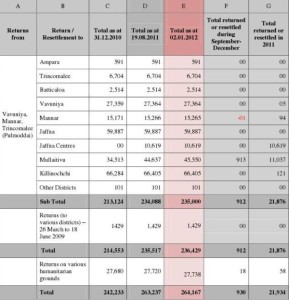
* The total number of persons returned from Jaffna Welfare Centres as at 12.31.2010 was 10,252. This figure inexplicably dropped to 9,851 as per the Situation Report dated 19.08.2011. Such a drop could only mean that the total number of persons released from these centres had in fact reduced during this period. The figure of 9,851 is also depicted in the Situation Report dated 18.10.2011. However, in the Situation Report dated 31.10.2011, the figure was restored as 10,252. This fluctuation in the numbers released from Jaffna Welfare Centres remains unexplained.
1.2. Number of persons in camps3
The table below provides details on the number of persons remaining in specific camps. Column B depicts the number of persons in camps as at 31.12.2010, Column C provides the figures as at 19.08.2011 and Column D provides the figures as at 02.01.2012. Based on these figures, it is possible to calculate the total number of persons released from camps.
For instance, Column E depicts the number of persons released during the period September to December 2011 i.e. the net difference between Columns C and D. Column F depicts the total number of persons released from camps in 2011 i.e. the net difference between Columns B and D.
By the end of 2011, the total number of persons in camps reduced from 16,747 (as at 12.31.2010) to 6,660. Hence the total number of persons released from camps during 2011 is 10,087.
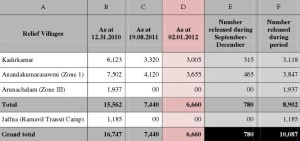
1.3. Discrepancy in numbers
The statistics released by the Ministry of Resettlement ought to accurately reflect the return and resettlement of persons held in camps. Hence the number of persons returned or resettled during a given period should match the total net decrease of persons in camps during that period. However, as highlighted in the previous Resettlement Report (August – September 2011), there appears to be a critical discrepancy in the official statistics.
According to the above figures, the total number of persons returned or resettled from 31.12.2010 to 02.01.2012 is 21,934. However, the total net decrease of persons in camps between 31.12.2010 and 02.01.2012 is 10,087. There appears to be a discrepancy of 11,847. A discrepancy is also reflected when the total number of persons returned or resettled during September to December 2011 (1,331) is compared with the total net decrease of persons in camps during the period September to December 2011 (780).
It may be argued that 11,847 persons returned or resettled during this period have not come from camps. This explanation was considered in our previous report, in which a discrepancy of 11,296 was examined in detail. It is reiterated that, according to consultations previously held with camp managers and Government Agents, the approximate duration of time between a release from a camp and return or resettlement to a district of origin is one to two days. Thus the discrepancy can only be a result of persons not previously held in the abovementioned camps being ‘returned’ or ‘resettled’ in particular areas. These persons could have been in the care of host families and thus not reflected in the net decrease of persons in camps. However, to date, the government has not presented any official explanation for this discrepancy.
It is noted that accurate data on the last location of displacement is extremely important in determining a number of crucial issues. For instance, such information would be important to determine entitlement to assistance and compensation i.e. whether those who are resettled have in fact been ‘displaced’ and are entitled to assistance and new lands. In the circumstances, the above discrepancy ought to be explained in the government’s situation reports.
2. Qualitative Analysis
2.1. Status of returnees and resettled persons in the Vanni
Each resettlement report released by the TNA will focus on a location in the Vanni, in order to provide a qualitative snapshot of the status of returned or resettled persons.
A total of 66,405 persons have been returned to or resettled in the District of Killinochchi since the end of the war. A further 45,550 persons have been returned to or resettled in the District of Mullaitivu. Owing to a dearth in precise data with respect to the current status of these persons, field research was conducted with respect to the following key areas of concern. The following areas are discussed in relation to the village of Santhapuram in the District of Killinochchi, in order to provide a qualitative snapshot of the status of the returned persons.
1. Basic needs
2. Healthcare
3. Livelihoods
4. Human security
5. Education
Krishnapuram and Vinayakapuram, both villages in the Killinochchi District were selected for purpose of the August-September report. The village of Santhapuram in the Killinochchi District was selected for the purpose of the present report. Most IDPs were returned or resettled in Santhapuram in August 2010.
The data presented below was collected through consultations with returned and resettled communities and state officials.
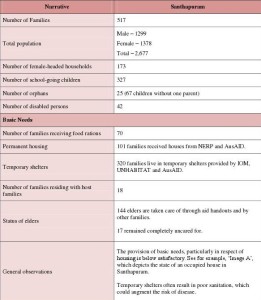
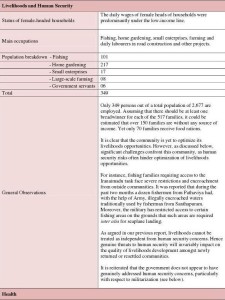
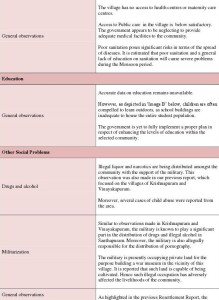
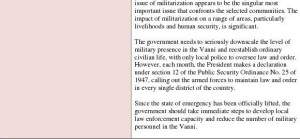
3. Special Issue: Kombavil
Kombavil is located in the Puthukkudiyiruppu (PTK) Divisional Secretary’s Division in the Mullaitivu District, approximately 1 KM from the Kaiveli Junction on Paranthan-PTK road. It is proposed as the location for a special settlement for displaced communities remaining in IDP camps.
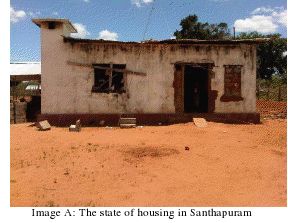 However, the proposed settlement is to be established in a dense jungle area known as ‘Timpili’ close to the Sri Lanka Army 68th Division Training School.
However, the proposed settlement is to be established in a dense jungle area known as ‘Timpili’ close to the Sri Lanka Army 68th Division Training School.According to government sources, the government has undertaken this project as a temporary solution until the full completion of the ongoing demining process in seven Grama Niladhari (GN) Divisions of PTK and three GN Divisions in Maritimepattu. However, according to military sources, the Kombavil project is a permanent measure to resettle certain communities, as their places of origin would continue to be in military custody even after the demining process is completed.
According to verified figures, 7,394 IDPs belonging to 2097 families, who are currently accommodated at the Menik Farm ‘Relief Village’, will be resettled in the new Kombavil settlement. Each family will be provided with a 40 perch block of land and a semi-permanent house within the settlement. An area approximately 600 acres in extent has been initially cleared for this purpose.
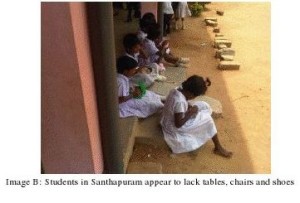 The proposed area is reported to be heavily mined. Hence the Sri Lanka Army has been deployed for the purpose of clearing the mines. It is reported that during the demining process, the entire area is ‘bulldozed’, thereby severely altering the soil layers. This altering could pose significant challenges to the resettled community in terms of future land cultivation.
The proposed area is reported to be heavily mined. Hence the Sri Lanka Army has been deployed for the purpose of clearing the mines. It is reported that during the demining process, the entire area is ‘bulldozed’, thereby severely altering the soil layers. This altering could pose significant challenges to the resettled community in terms of future land cultivation.On site observations reveal that Kombavil is an extremely remote area surrounded by thick jungle. It was observed that the proposed houses were very small and appeared to be extremely basic. Workers on site confirmed that all houses would be a standard size of 12 feet by 15 feet, irrespective of family needs. The government had decided to send a first batch of 100 families to Kombavil on 5th October 2011. However, by end-November 2011, only 73 families had been resettled. Workers on site observed that owing to the jungle and uneven ground, it would be difficult to complete even the basic semi-permanent shelters and toilets on schedule. On site observations further revealed that the ground water level is comparatively deeper than usual. Moreover, no infrastructure was in place to access the water.
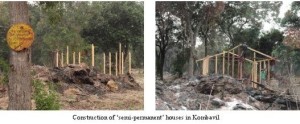
Incidentally, not a single labourer from the PTK area has been employed for the project, despite incredibly high levels of unemployment amongst the PTK community and the IDPs in general. Only the military and some labourers from Trincomalee and other parts of Sri Lanka have been employed.
The communities that will be resettled in Kombavil come from coastal villages such as Mathalan, Valaigarmadam, Mullivaikal East, Mullivaikal West, Pokkanai, Vadivakal, Chalai, Ampalavan-pokkanavai, Aananthapuram, Manthuvil and Kepapulavu. The primary occupation of these communities is fishing. However, the Kombavil settlement is many kilometers away from the coast—some estimates indicate that it is approximately 8 KMs from the coast. Moreover, due to the depth of ground water levels, the option of farming appears to lack feasibility. The future sustainability of these new communities remains imperiled, as there are strong indications that the ‘Kombavil solution’ would be a permanent one. Despite the government’s claim that the arrangement would not be permanent, it is reported that at least nine permanent villages would be established in Kombavil.
The consistent claim of the government has been that the communities’ places of origin are unsafe owing to Unexploded Ordnance (UXO).
Military sources indicate that UXO pose a major threat to resettlement. However numerous counter-narratives on the issue raise doubts over the authenticity of this claim. For example, the military is reported to have initiated restaurants and tourism ventures in these areas and even constructed a war museum. Hence the claim that the sole barrier to resettlement in these places of origin is the presence of UXO appears to be false.
The new settlement in Kombavil lacks schools and places of worship, thereby stifling the education and spiritual wellbeing of the resettled communities. Children would be compelled to walk significant distances to reach schools in PTK, Vallipunam or Udayarkaddu. The only hospital in the vicinity is located in PTK.
Moreover, there are no proper roads to the Kombavil settlement, which could cause a significant burden to the vast community that is intended to be resettled there. It was observed that the entire area is easily flooded in the event of heavy rain. Thus the lack of proper access roads could also seriously undermine relief efforts in the event of flooding.
Many of the families already settled in the area expressed serious concerns in terms of basic needs, livelihood opportunities, education and healthcare facilities. Further, widows expressed concerns about security and the difficulties they would face in such an unknown area in terms of rebuilding their lives and establishing livelihoods without the support of men. The surrounding jungle and the proximity of the 68th Division Training Camp were perceived as a serious security threat to the residents.
4. Special Issue: High Security Zones
4.1 Outline of the issue
The principal issue is whether there is an acceptable process in place to ensure long-term sustainability of returns to areas demarcated as HSZs in the North of Sri Lanka.
The extent of land covered by HSZs was increased and expanded by the government during the war, causing the protracted displacement of thousands of civilians. Many of the HSZs have not been officially gazetted as such. Hence it is difficult to accurately estimate the extent of land comprising HSZs. In the District of Jaffna, for instance, estimations of land covered by HSZs vary between 18% and 30%. Consequently, the estimates of persons displaced as a result of these HSZs vary from 70,000 to 130,000. Following the cessation of hostilities in May 2009, the government announced its intention of ‘releasing’ areas demarcated as HSZs in the latter part of 2010.
Apart from the deprivation of property and loss of livelihood over protracted periods of time – commencing from as far back as 1987 – the imposition of HSZs has had far reaching effects. The gradual disintegration of infrastructure and private property are some of these effects. In certain instances, the extent of the disintegration has made it impossible to identify or demarcate the boundaries of individual lands and properties.
The present challenge is far greater than merely demining and releasing the land, and returning the displaced. The overarching consideration is whether returnees are able to permanently remain on the land to which they return, in a sustainable and durable manner.
The ability for individuals and families to permanently return to their places of origin within the HSZs would be a good indicator of whether returns to HSZs are sustainable (though it would not be conclusive of the conditions within these zones). For the purposes of this report (and for future monitoring of HSZs), the ‘number’ of those who have permanently returned will be used as a general indicator of ‘sustainability’. Future reports will, however, attempt to qualitatively assess the status of returnees to HSZs. It should be noted at the outset that a special committee to oversee HSZs in the District of Jaffna was appointed following the cessation of hostilities.
The core questions with regard to HSZs are as follows:
1. Immediate question: How many of those displaced from HSZs are able to (physically) return to their lands, which have been ‘released’ for resettlement?
2. Long-term question: Is there a plan and policy in place for the rehabilitation and reconstruction of HSZs?
The Valikamam North HSZ (located in the Tellipalai DS Division) was selected for the purpose of this study, particularly in terms of analyzing and progressively monitoring the ‘sustainability’ of returns to HSZs. The Valikamam North HSZ covers a land area of 58.6 KM2 and has a total population of approximately 83,000 persons. Valikamam North comprises 45 Grama Niladhari (GN) Divisions of which 35 GN divisions fall within the HSZ.
4.2 Recent developments
Breakdown of the 45 GN Divisions in Valikamam North
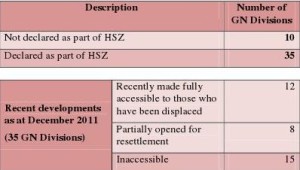
The ‘release’ of militarized zones and buffer zones commenced in March 2010, when three buffer zones surrounding the Valikamam North HSZ were officially released for the return of IDPs. Moreover, the first three GN divisions to be released, in November 2010, were from Valikamam North.
In January 2011, prior to the Presidential elections, the government promised the release of a further nine GN divisions,4 which were subsequently released after an official ceremony in May 2011.
According to the Tellipalai DS Secretariat, a total of 12,274 individuals and 3,511 families were to be resettled in their homes after 21 years. However, official numbers, released by the Tellipalai DS Division and Valikamam North Pradeshiya Sabha, for those who have been ‘settled’ in the GN divisions that have been made accessible, indicate lower figures i.e. 6,508 individuals and 2,096 families.
Overall, there is a wide disparity amongst official numbers for those who have ‘settled’, ‘registered’ and actually ‘returned’ (permanently) to the Valikamam North HSZ:

In the above chart, official numbers for the total number of families and individuals already ‘settled’ and ‘to be settled’ in the Valikamam North HSZ is 15,584 families, and 52,500 individuals. It is assumed that a total of 52,500 persons were displaced from the Valikamam North HSZ during the course of the conflict; that is, approximately 63.25% of the population of Tellipalai DS division. Of these individuals 30,764 are recorded as having ‘settled’ within the released GN divisions of the HSZ. These individuals and families have been compulsorily ‘de-registered’ from their areas of displacement (i.e. the DS and GN divisions in which they were located at their last point of displacement), and are officially considered to have returned to their homes within the HSZ. However, those who have registered with the GN offices in their areas of return amount to only 13,656 individuals. The approximation for those who have actually physically returned to the HSZ is even less, at 7,500 individuals.
According to the Government Agent’s office in Jaffna, official numbers for returns to Jaffna HSZs, as at December 2011, are 16,492 families and 56,031 individuals. These families and individuals for official purposes are considered to have returned to their original locations within the zones and re-integrated into their lands and homes. The actual returns (those who have permanently returned to the zones), however, approximate to around 7,000 families. Hence, the number of actual returns is, in reality, less than 50% of the total number of persons who are officially counted as having returned.
4.3 Analysis/ Progression
The release of HSZs commenced in the latter part of 2010. Considering the enormity of the problems associated with HSZs, a full normalisation of the conditions of return is likely to be a long-term process.
However, the process needs to take a realistic count of those who are yet to permanently return to the HSZs. The official numbers stated above imply that all persons displaced from the areas of the Valikamam North HSZ that have been released for resettlement (9,576 families and 30,764 individuals from the Valikamam North), have now returned to their original homes within the HSZs. This is far from the case, as indicated by the numbers above.
In addition to the problems highlighted above, displaced persons are reluctant to return to HSZs due to security concerns such as the presence of military checkpoints, the lack of income opportunities, a breakdown of infrastructure and services including hospitals and schools, and general reluctance on the part of families to return.
Many of those who have already returned continue to live in temporary shelters and tents. Some have received a Rs. 5,000 clearance grant, while others have not. The usual Rs. 25,000 assistance grant to which ‘newly displaced persons’ are entitled has not been given to those displaced from HSZs, as they have received assistance while displaced in camps or while staying with host families.
Plans to develop the North may not be sufficient to address the particular problems and issues within HSZs. A policy and plan to rehabilitate the HSZs needs to be developed, if returns to the zones are to be progressively sustainable.
4.4 Recommendations:
In view of the foregoing analysis, it is imperative that the government takes the following measures:
1. Identify in full the obstacles to durable and sustainable return to HSZs;
2. Provide a transparent account of the ‘actual’ returns to HSZs;
3. Establish short-term and long-term benchmarks for the rehabilitation of HSZs; and
4. Outline a targeted developmental plan for the HSZs.
5. Conclusions
1. Quantitative data:
Based on the above quantitative analysis, it may be reasonably concluded that 11,847 persons returned or resettled in 2011 did not come from the Kadirkamar, Anandakumarasawmi (Zone 1), Arunachalam (Zone III) IDP camps or the Jaffna Ramavil Transit camp. Hence it may be reasonably concluded that these persons came from unspecified locations in Vavuniya, Mannar and Trincomalee (Pulmoddai).
2. Housing needs:
It may be reasonably concluded that the government has not met the housing needs of a significant portion of returned or resettled persons in Santhapuram, the village selected for the qualitative analysis. At least 320 families continue to be in temporary shelters even two years after the cessation of hostilities. It is reiterated that most of the families were resettled in Santhapuram in August 2010. Even if these families were recently returned, the fact that they were returned without adequate housing provided in advance is a matter of serious concern.
3. Food and nutritional needs:
It may be reasonably concluded that the government has failed to provide food rations to a significant portion of families in need of such assistance in Santhapuram. Conservative estimates reveal that at least 150 families are in need of assistance, as only 349 persons are currently employed amongst 517 families. However, as only 70 families receive food rations, at least 90 families in dire need of assistance do not receive any assistance. This conclusion is starkly similar to the conclusions drawn in our previous report on the situation in Krishnapuram and Vinayakapuram.
4. Health and education:
It may be reasonably concluded that the government has neglected to consider access to adequate healthcare and education facilities to the selected village of Santhapuram. Where education is concerned, the lack of proper infrastructure is a cause for serious concern.
5. Militarization:
The government has failed to facilitate the proper transition of areas such as Santhapuram from a militarized environment, reflective of a situation of conflict, to a ‘normal’ environment. The high level of militarization in the areas surrounding the village is evidence of this failure. It may be reasonably concluded that the military occupation is directly linked to several social ills and livelihood deprivations in the selected village.
6. Kombavil:
The forgoing observations reveal that the government’s intended resettlement of Menik Farm IDPs to Kombavil is not in the best interests of the displaced communities. The proposed houses appear to be inadequate in size and hastily built on the assumption that they are only part of a temporary solution. However, there appears to be credible reports that the Kombavil settlement would be permanent.
Moreover, the proposed location is unsuitable in terms of viable livelihoods options and basic needs such as water, and creates extreme hardships to the communities in terms of access to healthcare and education. Given the general remoteness and the specific geographic location of the proposed area for resettlement, the newly resettled communities are also likely to encounter serious human security challenges in the future. In view of these observations, it is strongly recommended that the government take genuine measures to resettle the remaining displaced communities in their places of origin, especially in view that settlement in Kombavil is officially stated to be a temporary measure.
7. HSZs
It is clear that the government needs to develop a proper policy and plan to rehabilitate the HSZs in the North, if returns to the zones are to be progressively sustainable. In view of this need, it is strongly recommended that the government identify obstacles to durable and sustainable return to HSZs, provide a transparent account of the ‘actual’ returns to HSZs, establish benchmarks for the rehabilitation of HSZs, and present a targeted developmental plan for the HSZs.
____________________
1 Official Website of the Ministry of Defence, ‘Govt. to shut down Manik Farm, remaining IDPs to be resettled in Kombavil – PTK’, at http://www.defence.lk/new.asp?fname=20110920_01.
2 Source: Ministry of Resettlement.
3 Source: Ministry of Resettlement. It is noted that 5,440 persons released on temporary passes have not returned to the camp concerned and have hence been described as ‘absentees’. This figure is not included in the total number of persons in camps as at 02.01.2012 i.e. 6,660.
4 GN Divisions of Naguleshwaram (J/226), Thelippalai (J/228), Thanthaiselvapuram (J/230), Mavadipuram (J/231), Kadduwan West (J/239), Mavadipuram South (J/232), Palai Vemankamam North (J/236) and Palai Vemankamam South (J/237), and Kolankallady (J/225).